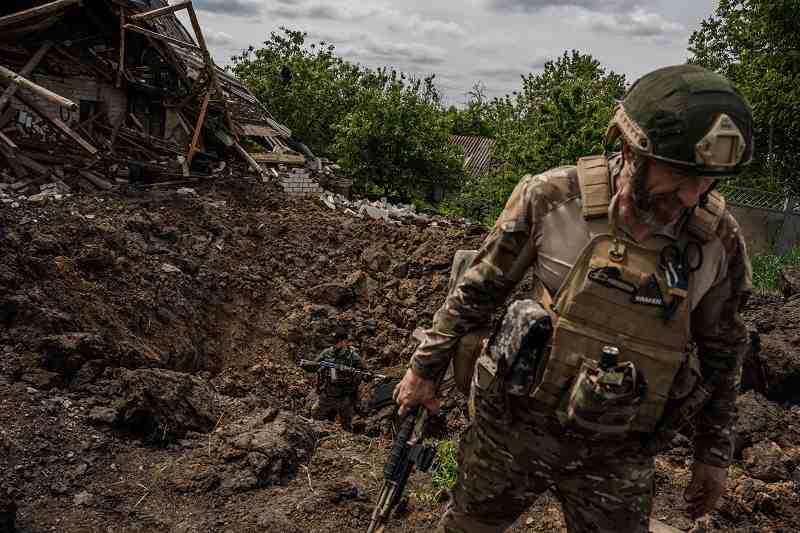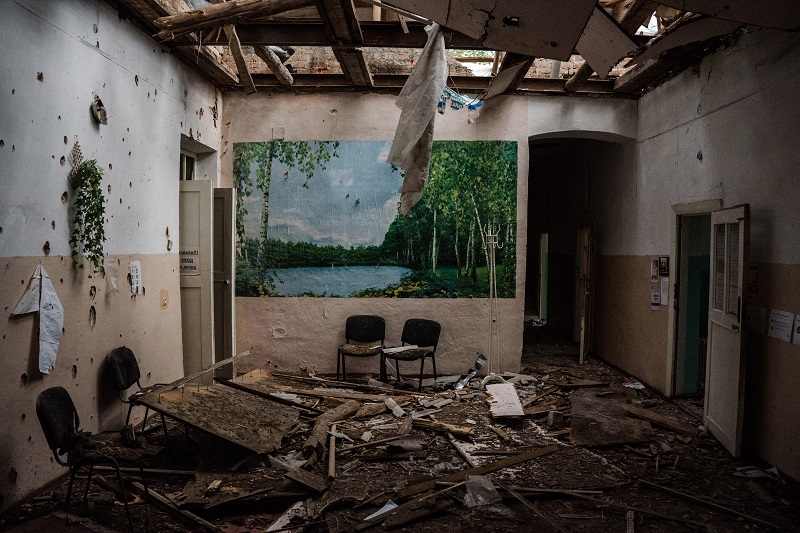
Kraken Regiment members Oleg Sapachenko and Andrii Maleev in Ruska Lozova, on May 30.
16:39 JST, June 4, 2022
RUSKA LOZOVA, Ukraine – The closest Andrii “Belyi” Maleev ever came to having a weapon in his hands was the hammer he used as a construction worker.
Then the Russians came.
A patrol of about 30 soldiers entered Maleev’s village on foot about 6 a.m. March 14, recalled Maleev, 45. Several stood outside his gate, pointing rifles at him, while two others searched his house and demanded to know whether he had any weapons.
When the soldiers left, so did Maleev – to get military training. Eventually, he returned to the village, this time as a rifle-toting member of the Kraken Regiment, a unit that is quickly becoming one of Ukraine’s better-known volunteer forces.
The Kraken unit was formed by Azov Battalion veterans on the day Russian President Vladimir Putin launched a full-scale invasion of Ukraine in February, a military spokesman said. That makes the Krakens something like a kid brother to the older Azov unit, whose fighters achieved world renown status last month for their epic last stand inside Azovstal, a sprawling steel complex in the port city of Mariupol.
Like the Azov fighters, whose name comes from the Sea of Azov, the regiment’s name and insignia evoke a different maritime theme: the kraken, a mythical sea monster resembling a giant squid.

Kraken Regiment members in Ruska Lozova
Their commander is Konstantin V. Nemichev, a political and military figure in Kharkiv. The son of a schoolteacher and an electrician, Nemichev, 26, launched a political career in the right-wing National Corps party before he graduated from college, including an unsuccessful bid last year to become Kharkiv’s mayor. He drew heavily on the support of rowdy young soccer fans, many of whom now serve in his unit.
Now that the Azov Battalion has been decimated, the Krakens stand to become Ukraine’s most famous band of volunteers – and arguably most controversial, like their Azov brethren. Critics said both have drawn fighters from ultranationalist and far-right groups, an allegation their soldiers reject as Russian propaganda. Although the commanders have acknowledged that far-right soldiers might be among their ranks, they said they are outnumbered by a more diverse group dedicated to defending Ukraine.
The Kraken unit operates somewhat in a gray zone – a force that answers to the Defense Ministry but is not part of Ukraine’s armed forces. Soldiers in Ruska Lozova say the unit has about 1,800 soldiers. The military spokesman declined to say how many serve in the unit.
The Kraken unit – which in recent weeks has helped take back villages north of Kharkiv – filled its ranks with “gym rats,” bouncers and “ultras,” the professional soccer fans who sometimes showed their love for Kharkiv’s Metalist team with riotous behavior. Many also hung out at the same sports bar, a place called the Wall, that was bombed, allegedly by Russian separatists, in 2014. Eleven patrons were injured.
But their unit also draws veterans from the regular army, battle-tested paramilitary fighters from Donbas and other volunteers who range in age from 25 to 60.
William – who would only give his first name because of concerns for his family’s safety – hitchhiked approximately 325 miles from Kyiv to join friends in the unit near the Kharkiv front. Now he walks with a limp from a Russian-made Claymore mine that peppered his right leg with shrapnel. Like others, he went to war after receiving combat training where first aid instruction was more plentiful than ammunition.
And there’s still more than a little DIY in the unit’s warcraft, despite nearly three months of sometimes heavy fighting. Their battle wagons are SUVs, pickup trucks, ATVs and – on this day – a Nissan Murano painted bumper to bumper in green, right down to the hubcaps. The camouflage on Anton’s AK-74 is homemade, too. Worried the factory-issue black finish might stick out in Ukraine’s forests, he painted his weapon in multi-tone greens that look more Grateful Dead tie dye than military camo.
“It was chaotic for the first week and a half,” said Anton, 27, who also only gave his first name for security reasons. He recalled how one soldier, feeling confident that he could instruct his comrades on how to fire a Czech antitank weapon, blew up a wall and injured several people instead.
Even now, on a quick tour of the village, the small Kraken squad is less than disciplined about basic firearm safety, such as pointing the weapon’s muzzle only at the sky or at the ground. While taking cover below a tree from a Russian drone overhead, one soldier leaned the muzzle of AK-74 against his crotch. Inside a blown-out hospital, another soldier knelt over an unexploded tank shell, pretending he was about to poke it with his finger.

Members of the Kraken unit hide under trees while a Russian drone flies overhead.
Yet Kraken members also have learned to fight by fighting, and their morale is high.
“I fought in Donbas and – how to put it? – things are better organized here,” said Oleg Sapalenko, 27, a member of the 25th Airborne Brigade who secured a transfer to the Kraken unit so he could fight for his hometown among friends. “Teammates are way better team players, and that helps a lot.”
All Ukraine needs, Anton said, is for the world to supply the weaponry to push Russian forces back across the border, and soldiers like him will supply the spirit.
“We’re fighting an empire, not some villages in our country,” Anton said.
The Krakens have also been accused of mistreating Russian POWs, a potential war crime. Last month, Moscow put Nemichev on a wanted list, alleging that he was responsible for “an attempt on the life” of eight Russian soldiers, according to a report in Tass, the Russian news agency. A BBC investigation into a video showing several Russian POWs being deliberately shot in the legs found that the Kraken forces had been operating in the area at the time. Nemichev denied the allegations in the BBC account. He didn’t respond to calls and texts seeking comment for this report, but his unit’s press secretary provided a Telegram post from late March in which Nemichev dismissed the video as “fake news” and said his unit was “always very humane” with POWs.
By the time the Kraken unit liberated this suburban village of about 5,000 people at the end of April, many had fled. Maleev estimated Tuesday that only 200 or so remained in what amounted to a newly liberated ghost town. Few here even stepped outside as Ukrainian and Russian forces continued to trade mortar fire.

A destroyed hospital in Ruska Lozova.
Much of the village has also been damaged or destroyed, including the Church of St. Nicholas, the village council building and a small hospital. Elsewhere, a tidy row of beehives stood in a field near houses whose heavy wooden roof beams had been snapped and charred. A massive crater lay not far from the gutted, ash-filled house where Maleev’s brother lived.
As in so many other places, Russian occupiers drank heavily and looted local homes and businesses, villagers said. Maleev’s mother, Claudia, 81, described how Russians even fed the local citizens meat they had stolen from a local processing plant when the conversation was interrupted by the sound of a Russian drone overhead.
“It’s buzzing,” Maleev said, hushing everyone. Russians often use drones to identify targets to attack. The sound is faint, like a gas-powered model airplane, but it was enough to cause members of the unit to break up the conversation and seek cover.
"News Services" POPULAR ARTICLE
-

American Playwright Jeremy O. Harris Arrested in Japan on Alleged Drug Smuggling
-

Japan’s Nikkei Stock Average as JGB Yields, Yen Rise on Rate-Hike Bets
-

Japan’s Nikkei Stock Average Licks Wounds after Selloff Sparked by BOJ Hike Bets (UPDATE 1)
-

Japanese Bond Yields Zoom, Stocks Slide as Rate Hike Looms
-

Japan’s Nikkei Stock Average Buoyed by Stable Yen; SoftBank’s Slide Caps Gains (UPDATE 1)
JN ACCESS RANKING
-

Keidanren Chairman Yoshinobu Tsutsui Visits Kashiwazaki-Kariwa Nuclear Power Plant; Inspects New Emergency Safety System
-

Imports of Rare Earths from China Facing Delays, May Be Caused by Deterioration of Japan-China Relations
-

University of Tokyo Professor Discusses Japanese Economic Security in Interview Ahead of Forum
-

Japan Pulls out of Vietnam Nuclear Project, Complicating Hanoi’s Power Plans
-

Govt Aims to Expand NISA Program Lineup, Abolish Age Restriction






















